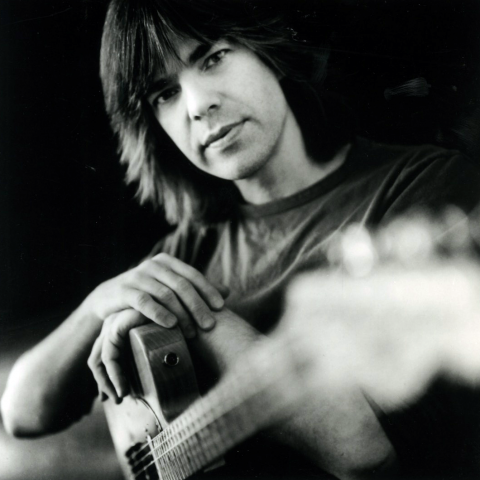"Fat Time, Play Me Something"
A look back at Mike Stern's classic "Fat Time" solo on the 1981 Miles Davis The Man with the Horn CD


Davis worked with many great guitarists during his career, but hiring a player with Stern's authentically edgy tone and blues-tinged bop and roll style brought a different flavor to the music that Davis was exploring in 1981. Stern's incendiary playing on "Fat Time” garnered a lot of attention—positive and negative—for both Davis and Stern. This auspicious debut with a towering figure of jazz paved the way for Stern's now-thriving solo career.
At the time, it was widely reported that "Fat Time" was the nickname Davis gave to Stern. The moniker was both a musical compliment and a playful personal jab. The more he heard him, the more impressed Davis was by Stern's time feel and phrasing, hence the reference to time. The name also poked fun at Stern, who was a little overweight then.
Stern says that Davis loved rock guitar and used to talk about guitar players with him frequently. "Miles was a huge fan of the guitar," said Stern. He really dug Hendrix. For me, getting to play with him was a real thrill but it was also terrifying."



Bill Evans, a saxophonist and friend of Stern's who was working with the Miles Davis band in 1981, was the link between Davis and Stern. The connection was made one night when Stern was playing with drummer Billy Cobham's band at the Bottom Line in New York. Evans showed up at the club with Davis. "I was nervous but excited too," said Stern. "Miles talked with Billy and told him to have me show up at Columbia Studios the next day. I didn't actually meet Miles until I got to the studio. The first thing he asked me to do was to solo all over his tune "Aïda." The tune already sounded finished to me, so I just did the best I could. It didn't really work, and my tracks weren't on the final mix. I think he just wanted to hear me play on his music."
About a week later, Davis called Stern to play on the session for what would become "Fat Time." It was recorded live in the studio with bassist Marcus Miller, drummer Al Foster, Evans, and Davis. Before running it, Davis showed them the chord progression at the piano. Imitating the trumpeter's raspy voice, Stern recalled, "He just said, 'It's got a c minor and then here it goes to A7—kinda like a Spanish thing—then B7.' We just said, 'Well okay, we'll wing it.' We played it and came up with a groove. Miles started suggesting a few other things for us to try but then just told us to play it our way. Before the take, Bill pulled me aside and told me, 'Don't be polite. Play with a lot of energy because that's what Miles wants to hear.' So I just let go."
After the first take, Stern wanted to go for another, feeling that he could get a better one. "I said, 'man, shouldn't we do it again?' Miles just said, 'Fat Time, when you're at a party, you gotta know when to leave.' The great thing about Miles was that he knew when to let go. If you try too hard to perfect it, you can take the soul out of a track. That was how he rehearsed too. He'd work on the music only up to a point, and then the rehearsal was over. We would have a few loose ends to deal with on the gig, but that kept things really fresh. He wanted that freshness even at the expense of things being really tight."
"Fat Time" ended up being the leadoff cut on the record. Some of the hallmarks of Stern's influential style can be found in this solo. His seamless blending of rock and bebop was first brought to a large audience by this tune. Stern's characteristic feel for syncopation can be heard in the playful dotted rhythms in bars 2 and 3, in the staccato notes found in bars 2 and 28, and then again in the closing bars 64 and 65.
Right after his opening, Stern draws on his blues-rock roots (you can hear him switch to his Fender Strat's treble pickup in bar 5 to get the right sound). With an aggressive, snarling tone, he plays some hyperspeed blues passages (bars 12 to 18) that call to mind Jeff Beck or Jimmy Page. He shifts at beat four of bar 19 and plays some jazzy chromatic lines (phrased nicely behind the beat). He interrupts the flow in bar 24 for some more blues. In bars 29 to 31, he aims for the A7 chord with an intervalic workout in fourths and a chromatic run.
Bar 32 is where Miles wanted the "Spanish" modal sound. Stern gets into a motoric groove (primarily in 16th-note triplets) playing rapidly arpeggiated A and B-flat chords to evoke a quasi-flamenco sound. Rock-solid phrasing and articulation draw attention to his powerful momentum and time feel. Around bar 39, as Stern recalled, he was expecting the A7 chord to change and was heading for the B7 chord. The chord didn't change, but Stern didn't falter, instead he ripped into one of the most interesting passages of the entire solo. Here, chromatic lines are interspersed with diminished chord arpeggios (see beat three in bars 42, 44, and 46, and beat one of 47). These are classic Sternisms.
When the B7 does arrive in bar 48, Stern lays back, blending some blues licks, pinch harmonics (produced by snapping the string against the right-hand thumb with the pick), and some fast arpeggios. The solo's most impressive display of technique and groove starts in bar 56 and continues until bar 62. Marcus Miller and Al Foster pump out a ferocious machine-like rhythm under Stern's relentless triplet figures. After hitting a peak in bar 63, Stern attenuates the energy as the chord changes to c minor 7. The syncopations and staccato notes echo his opening phrase. The atmosphere changes drastically and Stern plays a double stop, sustaining the ninth against the lowered third of the chord. The guitar fades back and Miles's muted trumpet lines take over.
Stern's take-no-prisoners guitar style was a concert attraction for this incarnation of the Miles Davis band and placed Stern in the spotlight. "I got a lot of good attention from musicians, but the critics weren't so crazy about it initially. It bothered me at first, but Miles said to ignore them. He told me, 'The only critic you need to listen to is me!' I loved playing with that rhythm section. It was so raw. Miles used to give us a lot of room to play on the gigs, sometimes it could drive you nuts. I would have just played and he'd come up to me after his solo and say, 'Fat Time, play me something.'"
Stern worked with Davis for nearly three years beginning in 1981, and then he left for stints with Jaco Pastorius and Dave Sanborn and to make his first record Neesh. A few years later, he returned to the trumpeter's band. When he saw him again and noticied that he'd lost the extra pounds, Davis quipped, "What, no more Fat Time?" Stern says that from that point on Davis just called him "Time."
After his work with Miles, Stern launched his own career in earnest in 1986 with the release of Upside Downside for Atlantic Jazz. To date, he has made 10 recordings for the label. His new disc Voices features Stern writing vocal music for the first time. The singers include Richard Bona, Elizabeth Kontomanou, Arto Tuncboyaciyan, and Philip Hamilton. The tracks also feature drummer Vinnie Colaiuta '75, bassist Lincoln Goines '76, and a cameo appearance by Michael Brecker. Voices contains what Stern feels is his best writing and playing to date.




